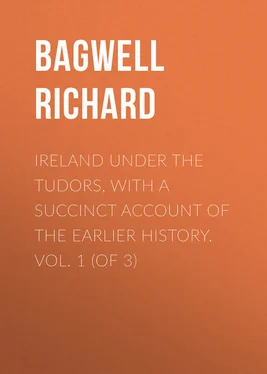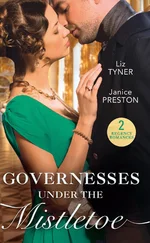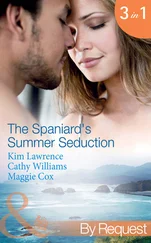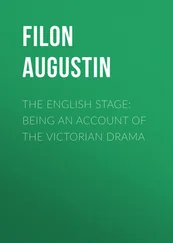Richard Bagwell - Ireland under the Tudors, with a Succinct Account of the Earlier History. Vol. 1 (of 3)
Здесь есть возможность читать онлайн «Richard Bagwell - Ireland under the Tudors, with a Succinct Account of the Earlier History. Vol. 1 (of 3)» — ознакомительный отрывок электронной книги совершенно бесплатно, а после прочтения отрывка купить полную версию. В некоторых случаях можно слушать аудио, скачать через торрент в формате fb2 и присутствует краткое содержание. Жанр: foreign_antique, foreign_prose, Историческая проза, на английском языке. Описание произведения, (предисловие) а так же отзывы посетителей доступны на портале библиотеки ЛибКат.
- Название:Ireland under the Tudors, with a Succinct Account of the Earlier History. Vol. 1 (of 3)
- Автор:
- Жанр:
- Год:неизвестен
- ISBN:нет данных
- Рейтинг книги:4 / 5. Голосов: 1
-
Избранное:Добавить в избранное
- Отзывы:
-
Ваша оценка:
- 80
- 1
- 2
- 3
- 4
- 5
Ireland under the Tudors, with a Succinct Account of the Earlier History. Vol. 1 (of 3): краткое содержание, описание и аннотация
Предлагаем к чтению аннотацию, описание, краткое содержание или предисловие (зависит от того, что написал сам автор книги «Ireland under the Tudors, with a Succinct Account of the Earlier History. Vol. 1 (of 3)»). Если вы не нашли необходимую информацию о книге — напишите в комментариях, мы постараемся отыскать её.
Ireland under the Tudors, with a Succinct Account of the Earlier History. Vol. 1 (of 3) — читать онлайн ознакомительный отрывок
Ниже представлен текст книги, разбитый по страницам. Система сохранения места последней прочитанной страницы, позволяет с удобством читать онлайн бесплатно книгу «Ireland under the Tudors, with a Succinct Account of the Earlier History. Vol. 1 (of 3)», без необходимости каждый раз заново искать на чём Вы остановились. Поставьте закладку, и сможете в любой момент перейти на страницу, на которой закончили чтение.
Интервал:
Закладка:
The native Irish had no regular towns. The Anglo-Normans took possession of those founded by the Ostmen, which were all on the coast, and founded many others, of which only three or four, and those not the most important, were at a distance from navigable rivers. Athassel in Tipperary is sometimes called a town, but it never became a municipality, and can have been little more than an aggregation of poor houses about the great monastery, and there may have been other similar cases. Dublin obtained its first charter from Henry II. in 1171 or 1172, and Drogheda from Henry III. in 1229.
‘Dublin and Drogheda,’ says the historian of the Irish capital, ‘were neither distinctly English nor Irish. Their citizens, as tax-contributing and acknowledged subjects of England, relied on her for protection against oppressive Anglo-Norman nobles and hostile natives. The Irish – unless Anglicised – had no legal part in these communities, but continuous mutual intercourse was sustained by the advantages derived from traffic.’ ‘In our documents,’ adds the same writer, ‘Scandinavians or Ostmans but rarely appear, although in 1215 the latter people were of sufficient importance to have been associated with the English of Dublin by King John as parties to an inquiry held there by his justiciary. The proportion of the various national elements cannot be absolutely determined by the forms of names;’ for many names originated in personal peculiarities, many were translated from one language to another, and many Irishmen became denizens, and adopted an English patronymic. The ‘Irish town’ which exists outside the old bounds of Dublin, Limerick, Kilkenny, Clonmel, and other places, doubtless perpetuates the memory of a time when the natives congregated in the neighbourhood of civic communities to which they did not belong. 35
What has been said of Dublin and Drogheda applies to the other cities and towns of Ireland. Limerick received its first charter from John in 1197, Waterford from the same prince in 1206, and Cork from Henry III. in 1242. These were the chief centres of trade and of English law in the south of Ireland. The less important municipalities owed their origin generally to some great noble, the Crown afterwards adopting them and granting fresh privileges. Kilkenny received a charter from the Earl Marshal between 1202 and 1218. New Ross, well situated at the junction of the Nore and Barrow, belonged to the same great man, and excited the jealousy of Waterford at least as early as 1215. Clonmel was included in a grant made by Henry II. to Otho de Grandison. It passed into the hands of the De Burgos, who probably incorporated it, and who received a royal grant to hold a fair there in 1225. Fethard, Callan, Gowran, and other inland towns were of less consequence, but were still distinctly English in origin and character. Youghal and Kinsale were also corporate towns. The latter received a charter from Edward III. in 1333, and the former, which had been long identified with the Desmond family, seems not to have been regularly incorporated till 1462. The Kinsale charter recites that the town was surrounded by Irish enemies and English rebels, and that the burgesses were worn out in repelling the same. The mediæval kings commonly granted the customs and tolls of loyal towns to be expended by the inhabitants in repairing their walls.
Galway has a history of its own. The O’Connors had a fortified post there before the Anglo-Norman invasion, and it soon attracted the attention of the invaders. In 1232 it was for the first time taken by Richard de Burgo, who lost it once, but recovered it and made it the capital of his province. The building of the walls was begun about the beginning of the reign of Edward I., and murage charters were granted probably by that king, and certainly by Edward III. and Richard II. A charter of incorporation was granted in 1396, but the names of certain chief magistrates, provosts, portreeves, and sovereigns, are preserved from 1274 to 1485, when the first mayor took office. Fourteen English families, afterwards known as the tribes of Galway, engrossed civic power, and from 1485 to 1654 every mayor, with a single doubtful exception, was chosen from among them. When the De Burgos turned Irish and renounced their allegiance, the loyal citizens soon learned to treat them as enemies, and in 1518 the corporation resolved that no inhabitant should receive into his house ‘at Christmas, Easter, nor no feast else, any of the Burkes, MacWilliams, the Kellys, nor no sept else, without licence of the mayor and council, on pain to forfeit 5 l. that neither O nor Mac shall strut nor swagger through the streets of Galway.’ Their great enemies were the O’Flaherties of Iar-Connaught, and it is said the prayer ‘from the ferocious O’Flaherties, good Lord, deliver us,’ was once inscribed over the west gate of the town. Athenry, which was built by the Bermingham family, was long and closely connected with Galway. It received a murage charter in 1312. 36
Besides the three great earldoms, there were several Anglo-Norman families who continued to have considerable importance in Tudor times. Robert le Poer, or De Poher, received a grant from Henry II., which made his descendants, now generally called Power, supreme in the eastern half of the county Waterford. In the middle ages they were often at war with the citizens of Waterford. Their chief seat was Curraghmore, and they are represented, through a lady, by the Marquis of Waterford. The western half of the same county, which came by marriage to the Desmonds, fell to the descendants of the seventh earl’s second son, known as the Fitzgeralds, of Decies, and seated at Dromana. The Fitzmaurices, descended from Raymond le Gros, occupied that part of north Kerry which is still called Clanmaurice. They became Barons of Lixnaw, and are represented by the Marquis of Lansdowne. The family of the White Knight was descended from Gilbert, eldest son of John More Fitzgerald by his second wife, Honora O’Connor; his half brother by Margery Fitz-Anthony being the first Earl of Desmond. The White Knights were called Macgibbon and Fitzgibbon, and their memory is preserved by the barony of Clangibbon, in the county of Cork. From John, the second of Honora O’Connor’s sons, is descended the Knight of the Valley, or of Glin on the Shannon. Maurice, the third brother, was the first Knight of Kerry. Another branch of the Fitzgeralds, known as hereditary seneschals of Imokilly, were settled in the fifteenth and sixteenth centuries at Castle Martyr. The Barrys, descendants of Nesta as well as the Geraldines, were settled in that part of the county of Cork called Barrymore; and the Roches were established soon after the first invasion about Castletown-Roche, and Fermoy. Of the families who obtained portions of De Lacy’s great territory, the most important were the Nugents, Barons of Delvin, and the Flemings, Barons of Slane on the Boyne. The Plunkets, who are supposed to be of Danish origin, were in the middle ages settled chiefly in Meath; and there they are still. They became Barons of Killeen, Dunsany, and Louth. The Prestons, Viscounts of Gormanston, and the Barnewalls, Barons of Trimleston, may also be noticed; but all the families of the Pale were overshadowed by the House of Kildare.
So far as the English colony in Ireland is concerned, the long reign of Edward III. must be regarded as a period of decay. The murder of the last Earl of Ulster in 1333, and the consequent secession of the De Burghs, hastened the destruction of a fabric which had always hung loosely together. The sons of Hugh Boy O’Neill, who was killed in 1283, established themselves firmly in Eastern Ulster, and undid nearly all the work of De Courcey and his successors. They gave to Antrim the name of Clan-Hugh-Boy, or Clandeboye, as it is now written. Only the Savages maintained themselves in Ardes; and the MacQuillins, a family of Welsh origin, between the Bush and the Bann, in the district afterwards called the Route. The three royal fortresses which bridled Connaught, Athlone, Roscommon, and Randon, all fell into the hands of the Irish. In Leinster also the natives rapidly gained ground. Lysaght O’More formed a confederacy of nearly all the midland tribes, and expelled the settlers from the district between the Barrow and the Shannon. His career was short, but his work was lasting. ‘In 1342,’ says Clyn, ‘he was killed when drunk by his own servant. He was a rich and powerful man, and honoured among his own people. He expelled nearly all the English from his lands, and burned eight of their castles in one evening. He destroyed Roger Mortimer’s noble fortress of Dunamase, and usurped the lordship of his own country. He was a servant, he became a lord; he was a subject, he became a prince.’ Bunratty Castle in Clare was dismantled by the O’Briens and Macnamaras, and a branch of the former established themselves in Tipperary. Of William Carragh O’Brien, of Aherlow, one of the chiefs of this sept, Clyn gives a very unflattering account. ‘He was,’ he declares, ‘a bad and perverse man who lived ill and died ill, passing all his time in waylayings, thefts, spoils, and murders.’
Читать дальшеИнтервал:
Закладка:
Похожие книги на «Ireland under the Tudors, with a Succinct Account of the Earlier History. Vol. 1 (of 3)»
Представляем Вашему вниманию похожие книги на «Ireland under the Tudors, with a Succinct Account of the Earlier History. Vol. 1 (of 3)» списком для выбора. Мы отобрали схожую по названию и смыслу литературу в надежде предоставить читателям больше вариантов отыскать новые, интересные, ещё непрочитанные произведения.
Обсуждение, отзывы о книге «Ireland under the Tudors, with a Succinct Account of the Earlier History. Vol. 1 (of 3)» и просто собственные мнения читателей. Оставьте ваши комментарии, напишите, что Вы думаете о произведении, его смысле или главных героях. Укажите что конкретно понравилось, а что нет, и почему Вы так считаете.












